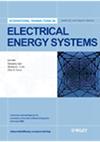{"title":"电力系统柔性评价与柔性综合优化","authors":"Sun Weiqing, Wang Chengmin, Zhang Yan","doi":"10.1002/ETEP.617","DOIUrl":null,"url":null,"abstract":"SUMMARY \n \nSmart grid puts forward new requirements in the planning, operation and management of power systems. Flexibility is one of the most important characters among the requirements. Traditional optimization analysis methods with single objective function and rigid constraints can hardly meet such requirements. This paper introduces the original concept of flexibility in industry process system analysis into power system analysis, analyzes their main differences and makes subdivision of power system flexibility into four kinds, namely property, constraint, load and structure flexibility. Rigid constraints in traditional analysis methods are transformed into flexible forms, and a power system flexibility evaluation method is proposed. Flexibility indices are defined and calculated to give intuitive measure of power system flexibility to grid dispatchers. Then, a flexible comprehensive optimization model in power system analysis is established. The result obtained is not an optimization for a single objective, but a comprehensive optimization considering system economy, safety and other objectives. Case study on IEEE 30-bus test system shows the validity of the methodology proposed. Copyright © 2011 John Wiley & Sons, Ltd.","PeriodicalId":50474,"journal":{"name":"European Transactions on Electrical Power","volume":"22 1","pages":"846-865"},"PeriodicalIF":0.0000,"publicationDate":"2012-09-01","publicationTypes":"Journal Article","fieldsOfStudy":null,"isOpenAccess":false,"openAccessPdf":"https://sci-hub-pdf.com/10.1002/ETEP.617","citationCount":"7","resultStr":"{\"title\":\"Flexibility evaluation and flexible comprehensive optimization in power systems\",\"authors\":\"Sun Weiqing, Wang Chengmin, Zhang Yan\",\"doi\":\"10.1002/ETEP.617\",\"DOIUrl\":null,\"url\":null,\"abstract\":\"SUMMARY \\n \\nSmart grid puts forward new requirements in the planning, operation and management of power systems. Flexibility is one of the most important characters among the requirements. Traditional optimization analysis methods with single objective function and rigid constraints can hardly meet such requirements. This paper introduces the original concept of flexibility in industry process system analysis into power system analysis, analyzes their main differences and makes subdivision of power system flexibility into four kinds, namely property, constraint, load and structure flexibility. Rigid constraints in traditional analysis methods are transformed into flexible forms, and a power system flexibility evaluation method is proposed. Flexibility indices are defined and calculated to give intuitive measure of power system flexibility to grid dispatchers. Then, a flexible comprehensive optimization model in power system analysis is established. The result obtained is not an optimization for a single objective, but a comprehensive optimization considering system economy, safety and other objectives. Case study on IEEE 30-bus test system shows the validity of the methodology proposed. Copyright © 2011 John Wiley & Sons, Ltd.\",\"PeriodicalId\":50474,\"journal\":{\"name\":\"European Transactions on Electrical Power\",\"volume\":\"22 1\",\"pages\":\"846-865\"},\"PeriodicalIF\":0.0000,\"publicationDate\":\"2012-09-01\",\"publicationTypes\":\"Journal Article\",\"fieldsOfStudy\":null,\"isOpenAccess\":false,\"openAccessPdf\":\"https://sci-hub-pdf.com/10.1002/ETEP.617\",\"citationCount\":\"7\",\"resultStr\":null,\"platform\":\"Semanticscholar\",\"paperid\":null,\"PeriodicalName\":\"European Transactions on Electrical Power\",\"FirstCategoryId\":\"1085\",\"ListUrlMain\":\"https://doi.org/10.1002/ETEP.617\",\"RegionNum\":0,\"RegionCategory\":null,\"ArticlePicture\":[],\"TitleCN\":null,\"AbstractTextCN\":null,\"PMCID\":null,\"EPubDate\":\"\",\"PubModel\":\"\",\"JCR\":\"\",\"JCRName\":\"\",\"Score\":null,\"Total\":0}","platform":"Semanticscholar","paperid":null,"PeriodicalName":"European Transactions on Electrical Power","FirstCategoryId":"1085","ListUrlMain":"https://doi.org/10.1002/ETEP.617","RegionNum":0,"RegionCategory":null,"ArticlePicture":[],"TitleCN":null,"AbstractTextCN":null,"PMCID":null,"EPubDate":"","PubModel":"","JCR":"","JCRName":"","Score":null,"Total":0}
引用次数: 7
Flexibility evaluation and flexible comprehensive optimization in power systems
SUMMARY
Smart grid puts forward new requirements in the planning, operation and management of power systems. Flexibility is one of the most important characters among the requirements. Traditional optimization analysis methods with single objective function and rigid constraints can hardly meet such requirements. This paper introduces the original concept of flexibility in industry process system analysis into power system analysis, analyzes their main differences and makes subdivision of power system flexibility into four kinds, namely property, constraint, load and structure flexibility. Rigid constraints in traditional analysis methods are transformed into flexible forms, and a power system flexibility evaluation method is proposed. Flexibility indices are defined and calculated to give intuitive measure of power system flexibility to grid dispatchers. Then, a flexible comprehensive optimization model in power system analysis is established. The result obtained is not an optimization for a single objective, but a comprehensive optimization considering system economy, safety and other objectives. Case study on IEEE 30-bus test system shows the validity of the methodology proposed. Copyright © 2011 John Wiley & Sons, Ltd.

 求助内容:
求助内容: 应助结果提醒方式:
应助结果提醒方式:


